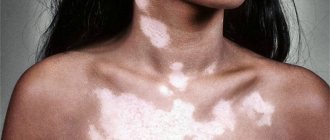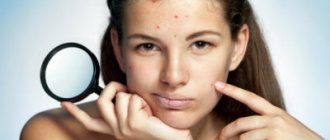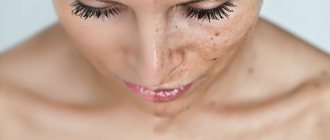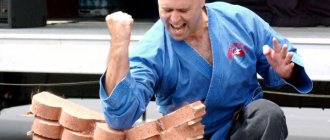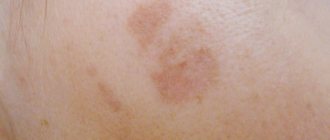Signs of skin photoaging
The main signs of photoaging are changes in skin turgor, elasticity, color and pattern. The pores deepen, causing them to be more clearly visible on the face. In places that are especially exposed to sunlight, spider veins - telangiectasia - appear. After 30 years, obvious signs of degenerative processes may appear - changes in complexion, dyschromia.
One of the very first signs that the skin is suffering from constant exposure to sunlight can be considered a pigmentation disorder. Melanin, found in epidermal cells, protects the skin from UV rays. Therefore, if the skin is constantly exposed to the sun, the synthesis of this pigment increases. But this process does not occur evenly, like tanning, for example, but in a targeted manner. Affected areas of skin darken and enlarge, or may return to normal with proper care.
Under the influence of UV rays, the skin's metabolic processes are disrupted, it loses more moisture, causing it to peel and lose elasticity. Increased insolation promotes skin tumors – fibromas. Their constant exposure increases the risk of developing papillomas and ephelides (freckles), lentigo.
The degree of photoaging is determined using a special Glogau scale.
1. Slight change in pigmentation. There are no obvious wrinkles yet, but the skin is dry and requires nutrition. Observed at 20-35 years of age.
2. Formation of facial wrinkles, increased pigmentation, slight change in normal complexion. Slight change in facial design. Typically between the ages of 35 and 60.
3. Wrinkles are visible even at rest; they are deep and clearly defined. Telangiectasia and dyschromia appear on the skin. Severe pigmentation disorder, dramatic change in color of individual areas. Most often it manifests itself in people over 50 years of age.
4. The extreme degree is typical for people over 60 years of age . Wrinkles appear on the entire surface of the skin, pronounced loss of elasticity, vascular changes, sagging, sagging of certain areas. The color becomes yellow-gray.
Another unpleasant skin factor is impaired sebum secretion. This is a natural barrier that protects it from external influences. It can be reduced or increased, but in any case, it only has a negative effect on the skin. Pores become clogged and inflammation appears, dry skin flakes, loses elasticity, and the protective layer becomes thinner. Also, exposure to sunlight can lead to changes in pH, which significantly aggravates the situation.
What is facial photoaging?
The fashion for a beautiful tan arose several decades ago and is in no hurry to lose ground. A bronze body looks much more attractive than a whitish one, and therefore relaxing on a sun lounger on the beach in the summer and regular visits to the solarium are perceived as a tribute to beauty. But doctors are sounding the alarm: tanning is not only not healthy, it also takes away the very beauty that every woman strives to preserve.
“Few people think that tanning is a protective reaction of the skin,” comments dermatovenerologist Vera Malinovskaya. — Darkening occurs as a response to exposure to ultraviolet radiation. If this exposure occurs frequently, the risk of skin cancer and photoaging increases.”
How does it happen? Ultraviolet light changes the structure of the skin. Its short UVA rays affect only the top layer - the epidermis, but are destructive. Regular “burns” caused by tanning eventually lead to the appearance of foci of microinflammation, obstruction of blood flow, and damage to the capillaries that nourish the skin. Cells do not receive sufficient nutrition, dehydration occurs, and cell membranes are destroyed.
Externally, signs of photoaging do not appear immediately. The skin is capable of active regeneration, and if it experiences excess ultraviolet radiation not often, but from time to time, it manages to restore its structure. Regular exposure to ultraviolet radiation is dangerous, as is its negative effect on aging skin. In this case, chronoaging manifests itself in a variety of symptoms:
- thickening of the skin - it becomes rough, porous;
- the appearance of age spots as a result of excessive synthesis of the protective pigment melanin by the dermis;
- dryness, peeling, sagging skin, the appearance of numerous small wrinkles.
“The first signs of photoaging can be seen in young women, aged 25-30,” continues Vera Malinovskaya. — For lovers of beaches and solariums, age marks appear early, and the skin fades very quickly. Photoaging is similar in symptoms to age-related changes, but occurs faster than natural.”
Prevention of photoaging
There are several ways to prevent skin photoaging. We are constantly exposed to sunlight, so reducing their impact on the human body is one of the main tasks. You should not deny yourself sunbathing, because it stimulates the formation of vitamin D, which is very important for the body. Initially, especially in the summer, it is worth using skin care products with UV protection against photoaging with a high SPF value. You must wear sunscreen on the beach.
You should not sunbathe between 12 and 15 hours , because at this time the penetration of sunlight is increased and there is a risk of burns. You cannot ignore the standard methods of protection against photoaging - a hat or cap. They do an excellent job, significantly reducing the level of insolation.
It is important to take care of nourishing the skin not only from the outside, but also from the inside. A great way to help your skin recover from increased sun exposure is with antioxidants. They help get rid of free radicals resulting from cell damage and promote regeneration.
How does the photoaging process occur?
It cannot be argued that the sun is necessary for the life and functioning of all life on the planet. Its moderate effect on the skin has beneficial effects, however, excessive use of tanning and constant exposure to direct UV rays provokes pathological processes accompanied by persistent morphological changes occurring at all levels of the skin layer.
Due to regular exposure to type A UV rays, active division of keratinocytes occurs in the skin, which are necessary for regular regeneration and keratinization of the epidermal layer. All possible changes in this process are fraught with heterogeneity of keratinization of the skin surface, leading to its thickening. Changes occurring on the surface will necessarily lead to pathological deformations of the deeper layers of the skin. “Solar elastosis” begins in the dermis, occurring with destruction of elastin structures associated with a violation of their texture, fragmentation, curling and a decrease in the total number. Then foci of chronic inflammation are formed with stagnant processes in the capillaries, leading to a further change in the direction of blood flow and the occurrence of stable vasodilation.
How to improve the condition of your facial skin
Unfortunately, skin restoration processes slow down with age, which is why the negative effect of the photo factor is more pronounced. When it becomes rougher, loses its natural elasticity, and degenerative changes appear, it is worth thinking about procedures that can help change the situation for the better.
You can resort to the biorevitalization procedure - artificial saturation with hyaluronic acid. It provides optimal hydration and restores protective properties. After the procedure, the skin looks more toned, fine wrinkles are smoothed out, and signs of facial photoaging are removed.
Laser resurfacing will help get rid of the rough layer. The principle of its action is aimed at several processes - removal of hardened cells, restoration of the synthesis of its own collagen. After the procedure, you can notice a significant result - the skin pattern is evened out, shallow defects and age spots disappear. Over the course of 3-6 months, the effect only increases, because the process of synthesis of collagen and elastin fibers and the formation of fibroblasts is intensified.
Peels have a combined effect against photoaging of the face. They not only help exfoliate dead cells, but also improve blood circulation and stabilize the formation of sebum.
Concept of photoaging
Changes occurring on the surface will necessarily lead to pathological deformations of the deeper layers of the skin
The combination of biochemical, clinical and structural changes in the epidermis caused by constant exposure to ultraviolet rays is called the process of photoaging. Its characteristic features are:
- excessive dryness of the skin;
- extensive brown pigment spots;
- changes in blood vessels in the subcutaneous layer;
- roughness of the epidermis;
- the appearance of small and deep folds/wrinkles;
- decreased firmness and elasticity of the skin surface.
Photoaging is diagnosed using dermatoscopy, biopsy and histological examination of the subcutaneous layer.
Chronoaging of the skin - what is it?
So, what is skin chronoaging? This term refers to the biological process of withering, caused by age-related as well as genetically determined changes in cells.
Unlike photoaging, which is caused by the adverse effects of ultraviolet radiation on exposed skin, chronoaging appears as a reflection of a person's age.
Thus, if during photoaging, loss of tone, pigment spots and other signs of aging do not occur on areas of the face or body protected from the sun, then with true aging, thickening of the stratum corneum, thinning of the capillary walls and other negative changes can be observed on any area of the skin.
How to protect yourself from photoaging?
To ensure complete protection against ultraviolet radiation, you need to pay attention not only to the SPF indicator, but also to the content of special filters against UVA rays in the chosen product. If the SPF level guarantees that sunburn will not spoil the surface layers of the epidermis, then for deeper protection of the dermis, other filters are needed, which are marked on the cosmetic bottle as PA+, SPF/UVA, UVA/UVB or simply UVA .
Creams with UVA protection - prevent photoaging
Therefore, choosing an untested sunscreen based on its cheapness or recommendations from market sellers is an unforgivable mistake that can lead to serious skin problems. Only professional cosmetics enriched with UVA filters can protect against both burns and solar aging of the skin. While leafing through the virtual catalogue, you should pay attention to the world leaders in the field of SPF:
1. Australian Gold. American cosmetologists were able to cover the needs of owners of all types (from dry to oily) and phototypes (from Nordic to Mediterranean) skin. Just determine your natural characteristics - and there will definitely be a couple of suitable sunscreen options in the Australian Gold lines.
These creams can often be seen on expensive beaches around the world.
2. Tannymax. German manufacturers have not avoided the problem of photoaging either. In addition to modern filters, the creams include powerful antioxidants and natural oils that restore and nourish delicate tanning skin.
3. Soleil Noir. French cosmetics rightfully occupy a leading position in the tanning industry. Extreme recovery is ensured by the maximum permissible content of vitamins and aloe, and the combination of filters guarantees protection against ultraviolet radiation of any length.
4. Ed Hardy. The professional cosmetics of this brand will be of particular interest to those with tattoos - the special formula of the sticks allows you to keep the color perfectly bright and saturated, despite the degree of tanning.
Means for protecting tattoos from the genius of his craft
Cosmetic procedures against chronoaging
The following procedures will help improve the appearance of your skin and cope with the signs of chronoaging:
- Biorevitalization. This technique involves the injection of drugs based on hyaluronic acid. As a result, the skin is moisturized, tightened, and its elasticity and freshness return. As a rule, experts recommend 3 sessions with an interval of about two weeks, and then maintenance injections every 2-3 months.
- RF lifting. The procedure involves exposing cells to radio wave pulses, through which age and expression wrinkles, spider veins, and age spots are eliminated. The duration of the rejuvenation course usually ranges from 6 to 10 sessions, each lasting no more than an hour.
- Mesotherapy. Mesococktail injections (which may consist of hyaluronic acid, vitamins, antioxidants or other beneficial substances) are not only an effective method against age-related skin changes, but also an excellent remedy for rosacea, hyperpigmentation and a number of other problems. The full course of treatment, depending on the severity of symptoms, includes from 5 to 10 sessions. The intervals between them are usually about a week.
- Contour plastic. The technique allows you to correct wrinkles by filling them with fillers based on hyaluronic acid. An important advantage of the procedure is that in most cases, one session is enough to achieve the desired effect: only sometimes a second correction is required after a couple of weeks. The results will last for up to one and a half years.
More about procedures
Biorevitalization SKIN
Facial mesotherapy
RF face lift
Elimination of the effects of photoaging
To remove from your facial skin the traces of a short holiday at a sunny resort or the manifestations of more serious problems that have accumulated over the years, you can contact a beauty salon to undergo treatment using cosmetic procedures.
For skin photoaging, the following procedures are indicated:
- Biorevitalization;
- Dermabrasion;
- Chemical peeling (glycolic or retinoic);
- Laser skin resurfacing (face, hands, décolleté);
- Mesotherapy;
- Photorejuvenation.
Biorevitalization
Treatment of photoaging using biorevitalization, which is carried out using hyaluronic acid, is very effective. As a result of this procedure, the epidermis is well moisturized and becomes more elastic, which significantly improves its condition.
Biorevitalization is performed using injections of hyaluronic acid preparations. This procedure will be effective already at the first appearance of signs of aging on the facial skin, which occurs at the age of about 30 years.
This procedure takes no more than an hour. First, the skin is cleaned, treated with an antiseptic, then a cream that has an anesthetic effect is applied to it, and then the drug is evenly injected under the skin.
The effect of this procedure will become fully apparent only after 2-4 weeks. Maintenance biorevitalization procedures should be performed every 3-4 months, since hyaluronic acid is absorbed in the body.
Dermabrasion
Treatment with dermabrasion accelerates the process of regeneration of dermal cells and activates the synthesis of collagen and hyaluronic acid. This procedure can be carried out using:
- Attachments made of abrasive materials (mechanical dermabrasion);
- Diamond particles;
- Flow of microscopic crystals.
Before the procedure itself, the area to be treated is thoroughly cleaned of contaminants and marked with a marker. To ensure that the patient does not experience discomfort, local anesthesia is used. This procedure lasts about an hour.
The full effect will only appear after a few weeks: at first the skin will be pink, but will turn pale over time. In addition to hyperpigmentation and wrinkles, using the dermabrasion procedure you can fight enlarged pores, scars and scars, and age spots.
Chemical peeling
Chemical peels using glycol or retinol are very effective in combating hyperpigmentation. The result of this procedure is a significant increase in collagen synthesis in cells and accelerated regeneration of the epidermis.
This procedure is used to combat age-related skin changes. This treatment can be used at any age for any type of skin. As a result of this procedure, the skin will become more hydrated, collagen synthesis will increase, and its protective properties will be restored. The best time to carry out this procedure is autumn-winter.
Laser resurfacing
Treatment of photoaging using laser resurfacing allows you to give the skin a healthy appearance, make scars and even scars less noticeable. As a result of this method, old dermal cells are removed and healthy young cells appear in their place.
Laser resurfacing helps with loss of elasticity, the appearance of heavy pigmentation and pronounced fine wrinkles.
Mesotherapy
The most effective treatment for the effects of ultraviolet radiation is done using mesotherapy. This technique involves the introduction of special “cocktails” of medicinal drugs under the skin of the face or body.
During this procedure, numerous injections are made over the entire surface of the treated skin area. In order for the effect of treatment to become noticeable, you need to do 4-10 procedures. As a result, you can get rid of skin hyperpigmentation, fine lines and wrinkles and dry skin.
Photorejuvenation
Treatment of negative changes in facial skin caused by exposure to sunlight using photorejuvenation is the most modern way to combat photoaging. During this procedure, the skin is exposed to pulsating light. Thanks to this effect, cell division accelerates, metabolic processes in the skin are normalized, its elasticity increases and even deep wrinkles are smoothed out. This treatment does not require pain relief and has no side effects.
Alternative tan
In order not to expose the skin to the harmful effects of ultraviolet radiation and to protect it from photoaging, you can resort to artificial tint using self-tanning products. Such drugs have long been used in dermatology to disguise depigmented areas of the skin, for example, with vitiligo. Preparations containing ketosaccharides (derivatives of fructose and glucose) cause a temporary effect of staining the cells of the stratum corneum. A tan appears on the skin a few hours after applying the solution or cream and lasts for 5-6 days. Self-tanning products for facial skin have a higher concentration of ketosaccharides, since the renewal cycle of epidermal cells on the face is shorter than on the body. Self-tanning preparations with ketosaccharides are absolutely harmless to the skin, they do not cause cell changes, do not affect the formation of pigment, and are not absorbed into the bloodstream.
Preparations containing ketosaccharides are not recommended to be applied to the skin after using soap. In this case, the slightly alkaline reaction of the skin after applying self-tanning gives an unnatural yellowish coloration. To improve the quality of self-tanning, it is necessary to maintain the normal acid-base state of the skin with the help of tonic and moisturizing preparations, or to specially create an acidic reaction of the skin using products with a high pH index (hydroxy acids, azelaic acid, etc.).
The uneven appearance of self-tanning on the skin significantly impairs its aesthetic perception. Uneven distribution of self-tanning can be caused by uneven thickness of the stratum corneum in different parts of the body or errors in applying the product. To level the excess layer of the horny epithelium, keratolytic and keratoplastic agents (salicylic, benzoic, azelaic, lactic acid, etc.) and scrubs are used. Uniform distribution of self-tanning is achieved by including silicone derivatives in the composition of products for artificially tinting the skin. Preparing the skin for artificial tanning can be done at home or in a beauty salon 1-2 weeks before applying tanning.
Eating certain foods containing carotene (such as oranges and carrots) also causes artificial coloration of the skin. Carotene is included in biological supplements for internal use (for example, Oxelio and many others). They are also recommended to be taken to improve the quality of tanning in solariums and in the sun.


